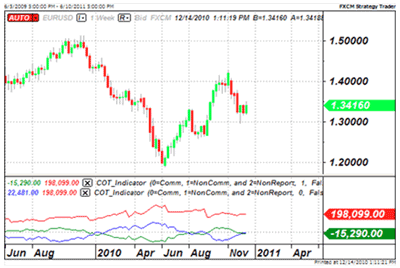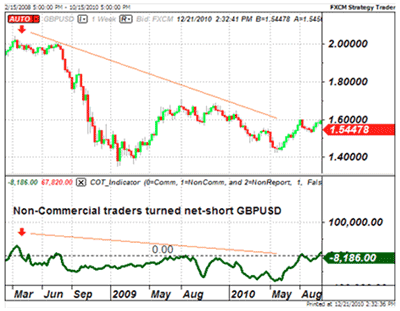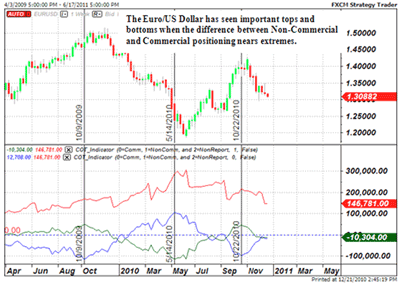By David Rodriguez, currency analyst, DailyFX.com
One of the most misunderstood, yet incredibly useful pieces of trading information is the Commitment of Traders (COT) report. The Commodity Futures Trading Commission (CFTC) COT report offers a unique look at the positioning of futures traders across a broad range of markets, and it is quite often used as a proxy for the FX trading market. In the weekly report, the US regulator breaks down long and short positions and overall open interest according to three separate trading groups.
Such a breakdown makes it unique from other positioning measures, and understanding the behavior of the three groups is essential in using the indicator as a tool for trading.
Commercial Traders: These are most often large multinational corporations with commercial hedging interest in their respective futures markets. For example, a large Japanese manufacturer may want to hedge their exposure to fluctuations in the US dollar/Japanese yen exchange rate.
Non-Commercial Traders: These are most often large speculators such as commodity trading advisors and similarly large institutions speculating in specific futures markets. For example, a major commodity fund believes that the US dollar will appreciate against the euro, and as such, places bets on euro FX futures.
Non-Reportable Traders: These are traders who don’t fall into either of the previous groups. Most often seen as small speculators, these are arguably less significant and do not frequently figure into COT report analysis.
With these general definitions in mind, we can then decide exactly how we might choose to use this information.
NEXT: How to Use the COT Report to Identify Trading Opportunities
|pagebreak|How to Use the Commitment of Traders Data to Study Trends
Given that Commitment of Traders data is released only once per week and on a delayed basis, it is difficult to use it as a market timing tool. This does not rule it out as a trading indicator, but it is important to keep this caveat in mind.
As such, we most often use COT information as an indicator to identify broader trends and potential reversals—not exact times for trading.
1) As a Trend Confirmation Tool
Given that non-commercial traders are most often large speculators, we expect them to generally move in favor of the major trend. Thus we watch when traders go in one direction to any significant degree and look to position ourselves accordingly.
The green line in the chart above plots net non-commercial positioning. That is to say the number of contracts long minus those that are short, giving us a metric for sentiment and positioning in the GBP/USD. Positioning flipped net-short the British pound against the US dollar when the GBP/USD traded above the 2.00 level. Though timing trend shifts is extremely tricky, we saw the pair consolidate before a pickup in short interest pointed firmly to the downside. Indeed, traders have broadly remained net-short the GBP until fairly recently, thus keeping it confined within an extended downtrend.
2) As a Trend Turnaround Tool
It is very difficult to time major market tops and bottoms, but we can get a better sense for when sentiment and positioning nears an extreme through Commitment of Traders data.
The chart above highlights major swings in net commercial and non-commercial positioning in the euro/US dollar currency pair. The line in green represents net non-commercial positioning, while the line in blue shows net commercial positions. Several of the past major tops and bottoms have roughly coincided with a fresh extreme in the difference between commercial and non-commercial positioning. It is obviously impossible to know exactly where such extremes occur, but we notice that subsequent weeks see the same difference moderate and warn of potential trend reversal.
In each of the three above instances, the major tops and bottoms occurred within two to seven weeks. This is hardly a perfect market timing tool, but such indications will give you a better sense of potential trend shifts.
By David Rodriguez, currency analyst, DailyFX.com
























